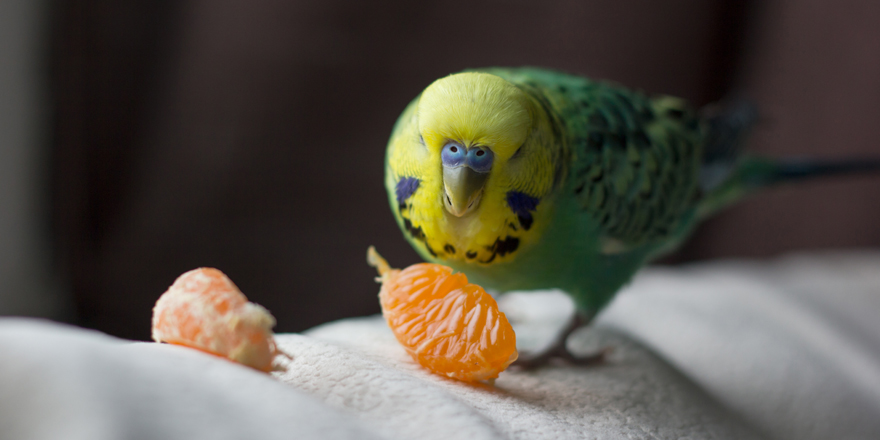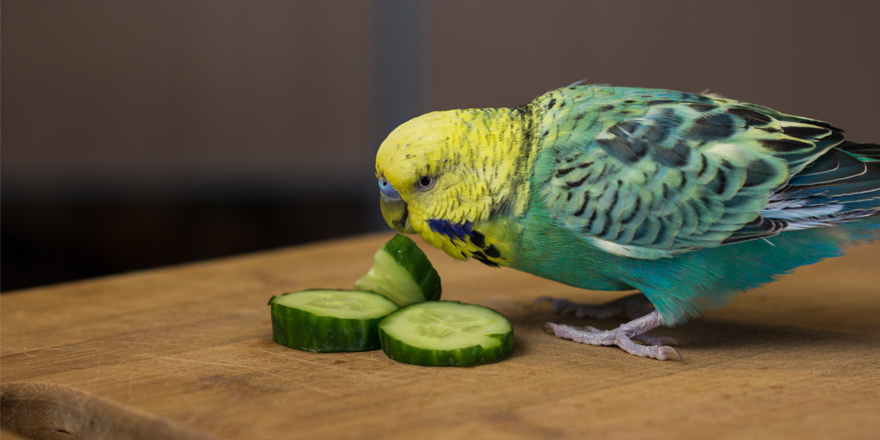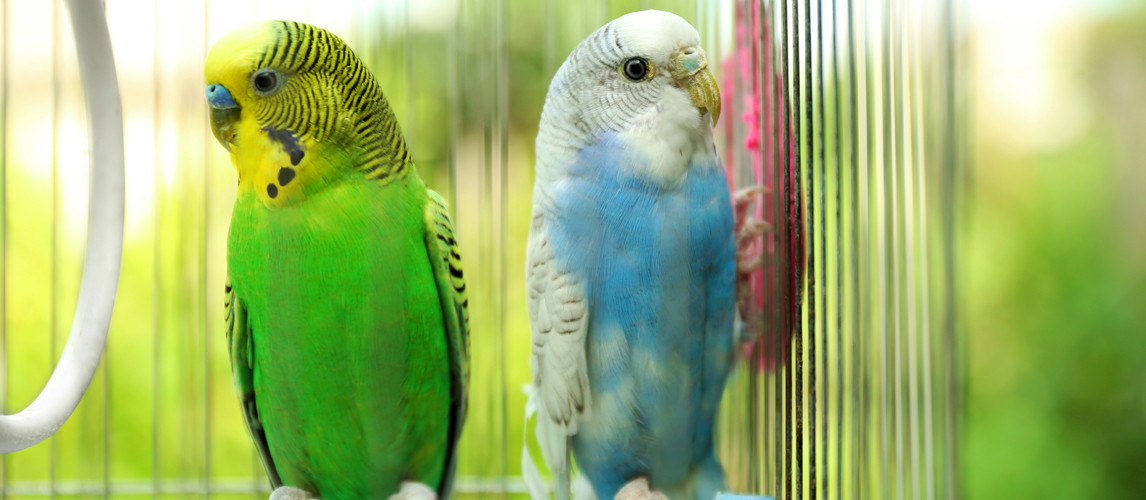Parakeets are popular pets, especially if you are short out of outdoor space or have not kept birds before. Friendly, vivacious, and engaging, they enjoy the interaction and with the right love and care, can live up to 12 years. But knowing what to feed your new parakeet is essential for their good health and wellbeing.
Alongside their core grain diet, we explore what else you should feed them, and ask the question – what can parakeets eat, when it comes to fruit and vegetables?
What is a Parakeet?
Also known as budgies (or budgerigars), parakeets are a native bird species from Australia, and are the world’s third most popular pet, after cats and dogs. Smaller than a parrot, these cute little pet birds love human company and come in a host of colors, although they are predominately seen in shades of blue, green, and yellow. They also have gorgeous long tail feathers to create a sleek body shape and are renowned for their ability to mimic sounds and words, making them entertaining pets.
As an indigenous Australian species, the parakeet’s natural habitat in the wild is the outback, where they nest in hollow trees. The parakeet is naturally a flock bird and survives by foraging seeds and vegetation they can find in the wild, as well as wild fruits. They also eat insects.
Pet parakeets are reasonably easy to care for, although their diet needs to be balanced and varied, to ensure your little bird is getting all the nutrients they need.
What is the Ideal Parakeet Diet?
While parakeets eat seeds and are known as ‘grainvores’, they need a more varied diet to thrive, both as a domestic pet and in the wild. And their desire to forage means they can eat much wider than the seeds they find, and so their diet as a domestic pet also needs to reflect this variation.
The ideal parakeet bird’s diet should include protein-rich foods such as seed and nuts – which can be found in shop-bought parakeet food, including parakeet pellets, as well as fruits and vegetables. Your aim is to feed your parakeet an appropriately balanced mix of essential protein, carbs, good fats, and essential fatty acids, vitamins, and minerals. The core diet that parakeets eat can be found in a high-quality bird pellet that contains the right nutritional balance, but you can also feed them fresh produce, including fruit and vegetables as well extras such as sprouted seeds. And don’t forget that your parakeet needs constant access to fresh, clean water.
How Often Should You Feed Them?
Parakeets should be fed every day and you can choose to either free feed (put out their daily food allowance in one go and let your bird feed as they feel like it throughout the day) or provide two separate mealtimes. This can also be the best option rather than free feeding if the weather is hot, as their food can quickly spoil. And when feeding at any time, never put fresh food on top of stale and always remove uneaten fruit or vegetables, as hygiene for your pet is essential.
To help you plan your parakeet diets, here are the main fruits and vegetables he can eat for a nutrient-packed treat.
What Fruits Can Parakeets Eat?
Parakeets can eat fruit, but before we look at the different fruits to feed your bird, it’s important to highlight that all fruits contain sugar. Too much of the sweet stuff can not only cause weight gain but lead to health problems such as diabetes. So, while fresh fruit can be good for your feathered friend, don’t overfeed, but use it as a treat.
The best fruits for parakeets are those that are excellent sources of key vitamins and minerals, including potassium and magnesium, as well as the vitamins C, A, and K. However when feeding fruit to your parakeet, you need to prep them properly, as the seeds, stalks, and skin of certain fruits can contain traces of cyanide, which can be harmful to your pet.
The fresh fruits to feed parakeets that will complement their birdseed diet include:
Apples
Apples are completely safe for parakeets to eat, as long as they are free of their seeds and are cut small enough to not be a choking hazard for your pet. And for many parakeets, apples are their favorite treat, plus they are packed with vitamins, including the all-important vitamin C as well as fiber.
Bananas
A super source of fiber and potassium, bananas are a nutritional treat for parakeets. With no fruit seeds, there’s no risk of cyanide poisoning when parakeets eat bananas and the soft flesh is easy for your feathered friend to eat and digest. Just be mindful of your portion size and don’t feed your pet too much in one sitting.
Blackberries and Blueberries
Juicy and budgie beak-sized, black, and blueberries are ideal for parakeets and mirror the bush fruit they would forage in the wild. And while the blackberry does have seeds, they don’t represent any risk and will pass straight through your bird (although this could cause you a bit of a mess as their droppings may then leave stains).
No prep, both blackberries, and blueberries are also nutrient-rich and are amongst the best fruit you can feed your pet birds.
Cherries
A good source of copper and potassium, as well as vitamin C and with juicy, soft flesh, cherries, are safe and nutritious for your parakeet, as long as the pit is fully removed as it can be toxic for birds. And make sure you cut the cherry into small portions and avoid feeding them whole, as they can get stuck in a parakeet’s narrow throat.
Grapes
Another fruit favorite of many parakeets, grapes are not only juicy, but they are also a good source of copper and vitamin K. But if you are wanting to treat your bird, then make sure you opt for the seedless variety and don’t feed grapes that are too large for their mouth. A small bunch of seedless grapes hung on the inside of their cage is a good way to serve as part of a balanced parakeet diet.
Oranges
The sweet citrus flavor of oranges is another fruit hit for parakeets, and they are also cheap to buy so make a good snack to have to hand. But never give an orange to your bird with its peel on, and always remove any seeds. Cut orange segments into bite-sized pieces too, so it’s not a struggle for your parakeet to eat.
Pineapple
This tropical fruit is an excellent source of vitamins B and C and will be a refreshing change when added to your parakeet’s diet. But prep is key with pineapple as you don’t want to feed your budgie any of that tough, woody skin and you will need to cut up the fruit flesh into smaller pieces. And be mindful of the amount of pineapple you do feed to your parakeet as it’s full of sugar.
Strawberries
Some pet owners worry when their parakeets eat strawberries as it’s impossible to remove all those tiny pips on the outside skin. But there’s no need to worry as parakeets love strawberries and the seeds are small enough to pass right through without causing any harm. And the strawberry flesh is a rich source of both vitamin C and folic acid as well as being soft and easy for smaller birds to eat.
Watermelon
Our final superfruit is the watermelon. Parakeets eat watermelon not just for the nutrition, but also for the water content. This makes melon a hydrating treat that can ensure your parakeets drink enough, especially on a warm day. A good source of vitamin C as well as the antioxidant, lycopene, the flesh is soft for your parakeet to eat. Just make sure you remove any seeds and the outer rind and cut them into small pieces. And watermelon should be fed sparingly as it is surprisingly high in sugar.

Fruits to Avoid
Fresh is always best when it comes to giving fruit to parakeets, so you do need to be careful if you are giving them dried fruit. Dried fruit can have a covering of sulfur, which is used to prevent mold, and this is something birds such as parakeets have a hard time digesting. If you do want to give your pet dried fruit, buy specific dried fruit for birds rather than the grocery store varieties.
However, there’s some fruit you should avoid feeding to your parakeet altogether, with the most notable being avocado. The skin, seed, and even the flesh of avocados can be toxic to all birds and can cause heart failure.
What Vegetables Can Parakeets Eat?
With less sugar than fruit and a healthy dose of nutrients, vegetables are a good addition to your parakeet’s core diet. However, balance is needed as too much veg can lead to watery droppings. The key to giving vegetables to your feathered pet is to ensure they are as fresh as possible and served raw. This way they can max out on those essential vitamins and minerals, such as vitamins A, B, C, and vitamin D as well as calcium and iron as part of a balanced diet.
The best fresh vegetables for parakeets include:
Beetroot
We all know beetroot is nutrient-rich, and there’s no reason why your parakeet shouldn’t benefit from all that goodness, which includes fiber, vitamin C, and iron. The best way is to serve it raw, peeled, and cubed, hanging the pieces from treat clips for an entertaining snack. Be warned – it can leave your pet with a temporary beetroot-dyed face!
Broccoli
Bursting with iron and calcium, broccoli is one of the easiest vegetables to give your parakeet, simply snap off a few of the tree-like stalks and feed through the wire or hand-feed.
Carrots
Carrots are one of the favorite vegetables that budgies eat, and they also get the benefit of its nutrients, including vitamin C and beta carotene. And they can eat the green carrot tops as well as the main veg. Serve in washed, appropriately sized chunks as a hand-fed treat or scatter around their cage for a snack on the go.
Cucumber
While they have little nutritional value, the beauty of cucumber is its water content, which means it makes a tasty, easy to digest, and hydrating snack on a hot day. Just be careful not to feed too much or too often as it can cause diarrhea in your bird.
Leafy Greens
If you only give one group of veg to your parakeet, then make its leafy greens. Not only do most parakeets find them delicious, but they also pack in the nutrients as well as extra hydration. Opt for dark green spinach, sweet romaine lettuce, dandelion leaves, or turnip greens.
Sweet Corn
As entertaining to watch them eat as they are delicious for your pet to eat, sweet corn is an ideal addition to the diet of your pet parakeet. Served raw and on the cob, cut into small sizes, sweet corn chunks can be placed on treat hooks or left on the floor of their cage for a sweet, nutritious mealtime treat.
Sweet Potato
Unlike all the other vegetables listed so far, sweet potato should be served cooked (either in chunks or mashed) as it can be too hard for parakeets to eat when raw. Along with pumpkin, sweet potatoes are a nutrient powerhouse for your pet bird, packing vitamins and minerals including vitamin D, calcium, iron, and magnesium.

Related Post: How to Tell If a Parakeet Is Male or Female
What Shouldn’t a Parakeet Eat?
So now we know what fruit and vegetables are good for your parakeet, we finish on what you shouldn’t feed your avian pet. And those foods are largely the things you find on your own plate. Human food, particularly processed junk food or fried food kind, are not good for birds as they are high in artificial coloring, fat, sugar, and salt which can cause a host of health issues.
And some human food is worse than others for your pet. In particular, you should avoid letting parakeets eat peanut butter as it can contain fungi which tends to grow on peanuts and can prove fatal. Avoid other types of nut butter too, as they are high in saturated fats, and don’t let your parakeets eat crackers, even the seeded variety.
Chocolate is also toxic for birds and can also contain caffeine which raises their heart rate. Meanwhile dairy contains enzymes that cause diarrhea in birds. And anything ‘sugar-free’ should be avoided at all costs as it can contain the artificial sweetener, xylitol which can cause severe liver damage.
In short, to boost your parakeet’s health, you need to make the right food choices so it eats as near to its natural diet in the wild to thrive. And so, alongside its core parakeet food of seeds and millet pellets suitable for birds, you should add bird-safe fruit and vegetables to create the ideal parakeet’s diet.





